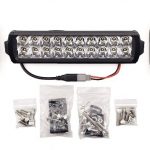One of the keys to growing a healthy lawn is providing the grass with three main nutrient sources – organic matter, water, and light. So what do you do if your lawn is covered by a canopy of branches and leaves, reducing the amount of light that can get through?
Choose the Right Grass to Survive in Shade
Certain grasses will survive better in the shade than others. Rye, fescues, zoysia, and St. Augustine grasses tend to survive better in the shade than most other types of grasses. Picking the right grass seed is a good idea as well – one that has a mix of different grasses instead of one particular type is your best bet. A variety of grasses will make it likely that, should one or two types not take hold or survive it well, the other grasses in the blend will take root and develop. A singular seed means that if it doesn’t like where you have planted it, absolutely nothing will grow from that seeding.
Consider Groundcover over Grass
Sometimes grass isn’t necessarily the way to go when trying to develop a lawn in the shade. Consider using a different type of groundcover that can survive better in the shade, and that won’t be as competitive with the tree’s roots for nutrients. Hostas and Japanese pachysandra are great options, and require very little in the way of consistent maintenance.
Reduce Stress on the Turf
When turf and grass is in the shade, the lack of light can make it even more open to stress, such as people walking on it constantly or animals using it. Make a path using pavers for people to walk on to avoid them stressing the turf. For animals, particularly dogs, keep an eye on them when they are in the yard and try to train them to avoid the shadier areas. This is easier said than done, but possible with attentiveness and training.
Prune Low-Hanging Branches
The lower branches in the canopy are what really block the sunlight from reaching the ground. Upper-level branches do block some sun, but they also allow rays to angle in and reach the ground. Prune some of the low-hanging branches to allow more sunlight to hit the grass. Removing branches within seven or eight feet from the ground is a good general rule to go by, however certain trees may need different considerations.
Don’t Skimp On Standard Care
Aeration, compost spreading, overseeding – these are all standard types of lawn care that should be done for all lawns, every year. Lawns that are not covered with shade can survive not receiving these types of lawn care throughout the year. Lawns that are covered by shade are desperately in need of these types of care though. Aeration will allow the grass to rather more air and nutrients, while compost spreading will provide organic matter and nutrients.
Utilize Hardscaping and Lawn Features
Through reducing the competition for nutrients and water, you can help give what grass you are planting a leg up. Eliminate the possibility of weeds by putting in hard features such as patios, rock gardens, dry creek beds, or Zen gardens.
So don’t think that you can’t grow a nice lush lawn in your well-shaded yard – you’ll just need to put a bit more effort into it than a nice, easy, open lawn.






